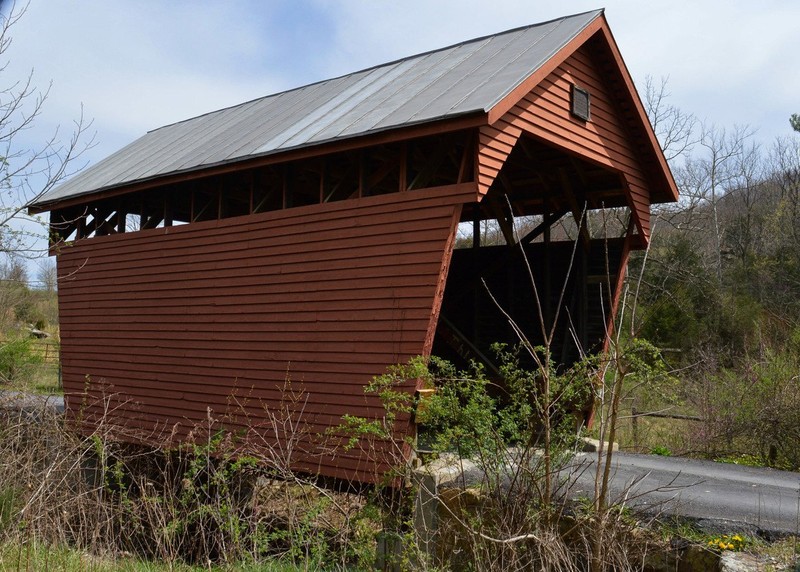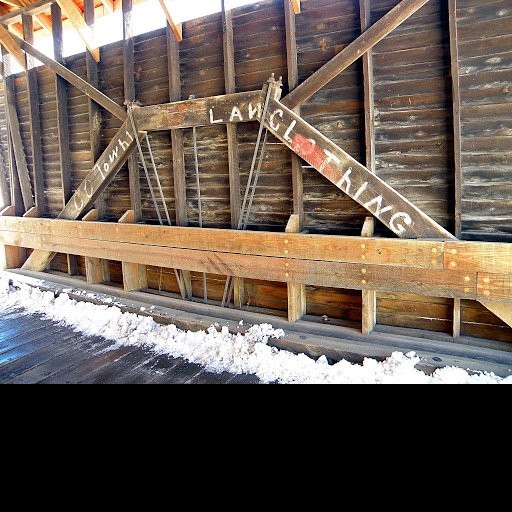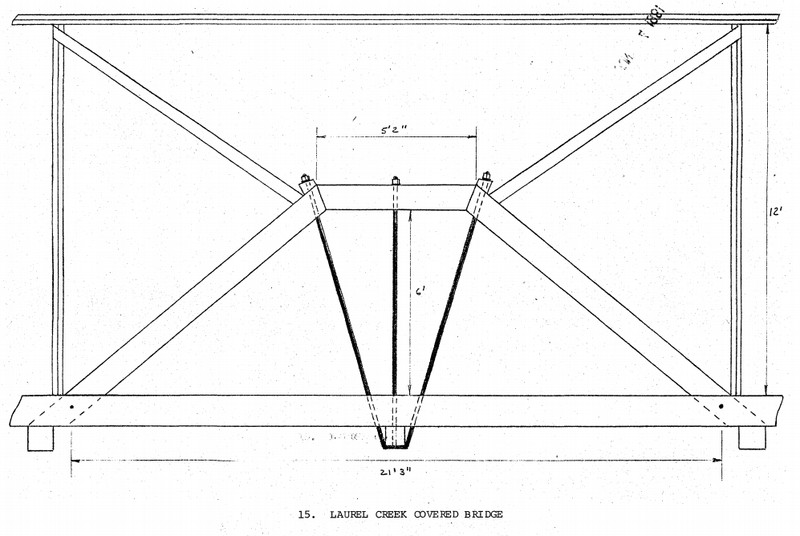Laurel Creek Covered Bridge
Introduction
Text-to-speech Audio
Images
Laurel Creek Covered Bridge

Interior of the bridge. A queenpost truss with metal tension rod connector is visible

Architectural drawing of Laurel Creek Covered Bridge's queenpost trusses

Backstory and Context
Text-to-speech Audio
In July of 1910, H. W. Peck, Robert Arnott, and county road engineer J. C. McClaugherty were appointed commissioners to propose a site for a new bridge crossing Laurel Creek. The people of Laurel Creek and Lilly Dale needed a secure means of fording the waters of Laurel Creek, especially in bad weather. When it rains hard, Laurel Creek has a habit of breaching the banks. The Laurel Creek Covered Bridge was designed to provide a safe and secure crossing point. In August, a site near Robert Arnott’s residence was chosen and the Monroe County Court ordered a covered bridge supported by stone abutments to be built at the site. Over the next year, Lewis Miller built the stone abutments while the superstructure was built by Robert Arnott himself. Lon Wickline created the chestnut shakes which once covered the roof. The iron components of the bridge were forged in Ronceverte. In August of 1911, the Laurel Creek Covered Bridge was completed at a total cost of $365 – approximately $10,000 adjusted for inflation.
At just thirteen feet wide and twenty-four and a half feet long, the Laurel Creek Covered Bridge is the shortest extant covered bridge in West Virginia. The wooden siding was originally painted red and the chestnut shake roof has been replaced with a galvanized metal one. The bridge is supported by a queenpost truss. This truss features two vertical beams connected by a horizontal beam. Diagonal braces span the distance between the edge of the bridge and the vertical posts. Uniquely, the queenpost beams in the Laurel Creek Covered Bridge are also connected by metal tension rods which loop beneath the floor. This adds an additional level of stability not found in other West Virginia covered bridges. This departure from other West Virginia covered bridges is likely due in part to the later construction date of the Laurel Creek bridge – a majority of West Virginia covered bridges were constructed before 1900.
The Laurel Creek Covered Bridge has remained largely unmodified since its construction in 1911. Sometime before 1981, the wooden stringers that once supported the deck were replaced with steel stringers. Additionally, the bridge was restored in 2000 by Hoke Brothers, Inc. for $248,692. This restoration seems to have been largely maintenance focused, as the bridge does not appear to display any recent structural modifications. The Laurel Creek Covered Bridge remains in use as a vehicle crossing. It is one of only two covered bridges left in Monroe County, the other being Indian Creek Covered Bridge. The Laurel Creek Covered Bridge is significant as a historical piece of infrastructure still used today, and for its unique design.
Sources
Hanson, Todd A. Covered Bridges, The West Virginia Encyclopedia. May 28th 2019. Accessed August 18th 2020. https://www.wvencyclopedia.org/articles/1660.
KCI Technologies, Inc and Mead & Hunt, Inc. West Virginia Statewide Historic Bridge Survey: Final Survey Report, Highways Through History. April 1st 2015. Accessed August 17th 2020. https://www.highwaysthroughhistory.com/Content/bridges/WVSHBSFinalSurveyReport.pdf.
Kemp, E L. Laurel Creek Covered Bridge, National Register of Historic Places. June 4th 1981. Accessed August 18th 2020. https://npgallery.nps.gov/NRHP/GetAsset/6ef71215-42ea-4611-bf8d-97d8251a5e2b.
Laurel Creek Covered Bridge, West Virginia Department of Tranportation. Accessed August 18th 2020. https://transportation.wv.gov/highways/bridge_facts/covered-bridges/Pages/LaurelCreekCoveredBridge.aspx.
Schmidt, Jack, J. P., and Brian McKee. Laurel Creek Covered Bridge, Bridge Hunter. November 15th 2019. Accessed August 18th 2020. https://bridgehunter.com/wv/monroe/laurel-creek/.
E. L. Kemp
